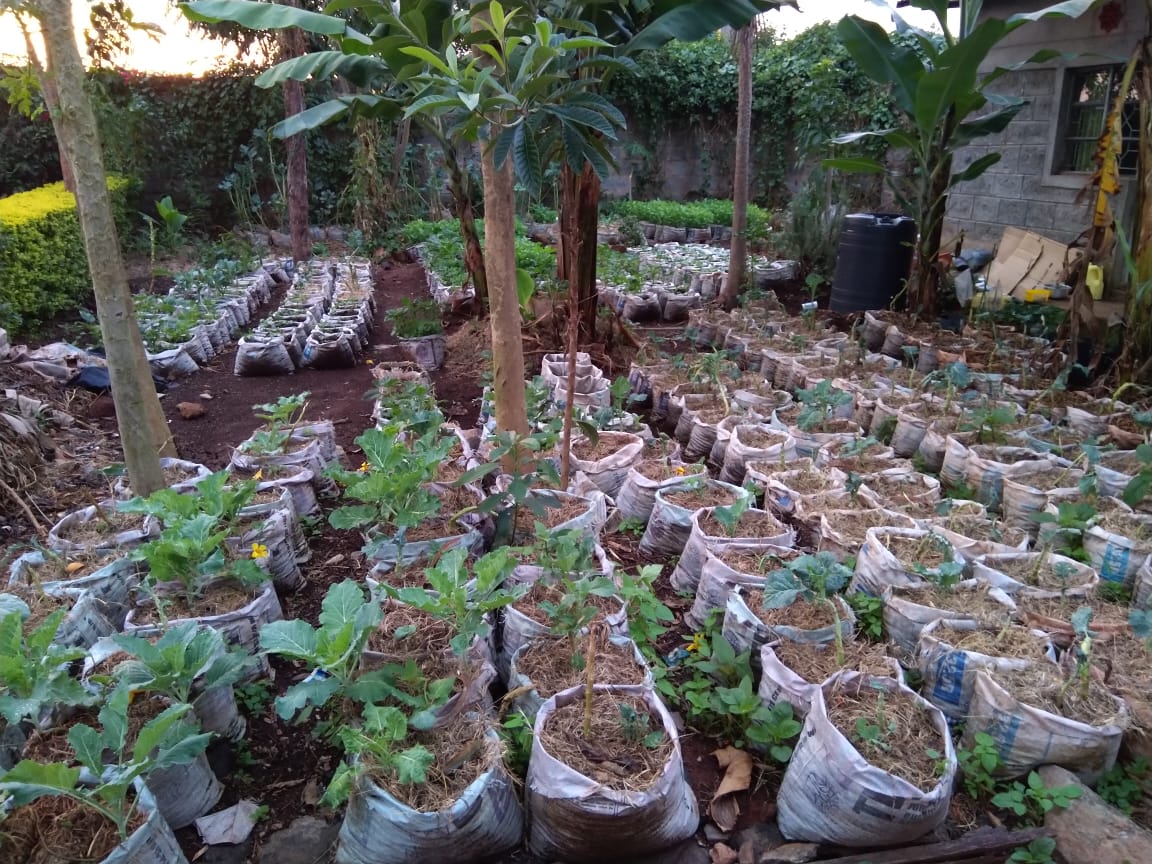By Jolene Njambi
A young farmer from the peri-urban Thika Central Valley is using more than 600 vertical bags to boost his food production six fold, fully maximizing the output from his limited space, while also halving his usage of irrigation water.
Five years ago, Kevin Kariithi from Thika Central Valley, was looking for a hobby after completing college when his mother, who is passionate about farming, suggested he try vertical farming.
Inspired by their neighbour, he and his mother began the vertical farming as a kitchen garden project, with just 30 cement bags. Today, their project has become an expansive vertical garden of 673 bags.
Related News: Kabete farmer moves into all-year, organic strawberries through vertical farming
Related News: Sack farming increases sukuma wiki production 75X in Makueni
“We liked the idea of starting our own garden. We wanted a steady supply of organic fresh produce straight from the garden and to reduce on costs we incurred from buying vegetables for our daily consumption. However, the lack of availability of adequate space presented a challenge. On seeing our neighbour successfully grow crops in cement bags, we decided to seek his counsel,” said Kariithi.
They soon learned that vertical farming is not only affordable and easily sustainable, it comes accompanied with other benefits such as efficient water use, prevention of the spread of diseases among crops, easier crop rotation, and better nutrient uptake by the crops as there is less competition for nutrients as the crops are grown individually.
Related News: Sack farming cuts irrigation water
Relate News: School uses sacks to grow vegetables instead of buying
It was a journey that began with them collecting 30 cement bags and buying 30 heads of sukuma wiki and spinach seedlings. They then dug up soil amounting to one wheelbarrow from a section of their plot, mixed it with chicken manure in the ratio of 1:1, adding a bucket of lime. They cut the cement bags in half, inserted inside the soil mixture and planted their seedlings.
What resulted was around 100 bags of produce within the first six months. This encouraged them to expand their vision and make further attempts at planting other crop varieties. Now, their 100 by 50 plot holds up to 673 bags of crops, across 73 bags of strawberries, 100 bags of pepinos, mulberries, oranges and mangoes and 500 bags of Sukuma, spinach and other indigenous vegetables arranged in rows for efficient use of space.

Kevin explains that his use of cement bags as opposed to large vertical bags made all the difference.
“The use of large vertical bags has a tendency of making the soil inside get compact thereby preventing water from reaching the bottom, all the way to roots. But with cement bags, crops are able to get maximum water absorption.”
Each bag holds at least three plants. One litre of water is used per bag and the crops are watered every three days. Strawberries, however, are a bit more demanding requiring to be watered every two days with a minimum of two litres of water.Through mulching, they have been able to conserve water, limiting the number of times they irrigate to a maximum of three times per week. This is because the soil is able to maintain moisture for a much longer period.
Currently, they use 1.5 kg of CAN fertilizer and 1 kg of DAP for the bags containing spinach, sukuma wiki and other indigenous vegetables. For the strawberries, they apply a foliar fertilizer at a rate of 10 ml per 10 litres.
Kevin admits that despite the benefits vertical farming has brought into their lives, they have had to overcome a few challenges along the way.
Related News: Fact sheet: how to make a vertical sack garden
Related News: Urban residents can reduce cost of living by using vertical bags to grow food
“One challenge of using cement bags is that they must be replaced annually as they easily get worn out by sunlight, which can be costly. However, this is not much of an issue for us as we live in an area where there are numerous ongoing construction activities that supply us with cement bags in bulk.”
“Turning cement bags every three weeks to ensure maximum sunlight utilization can at times prove tasking, but it only takes determination and consistency.” He adds.
Now, having experienced success in this venture, they look forward to making strides toward commercializing their produce.
“We have goals of further expanding our farm and leasing it to interested parties in the near future. We also hope to train people in other areas on how to venture into this method of farming as we have seen the promising results it brings and would be delighted to see other people experience the same.” He says.

Kevin Kariithi can be reached 0736873438
















Comments powered by CComment